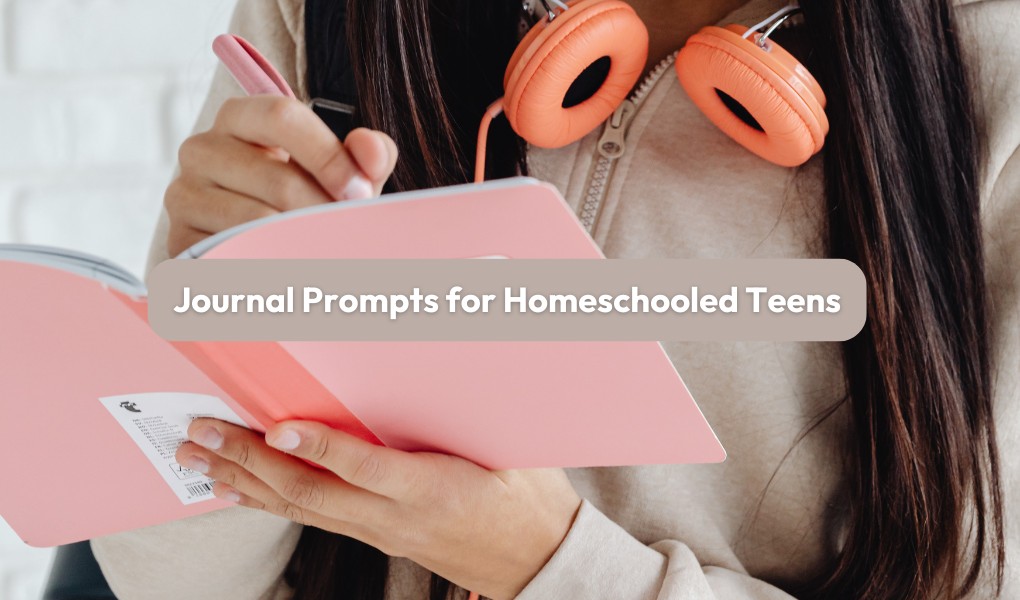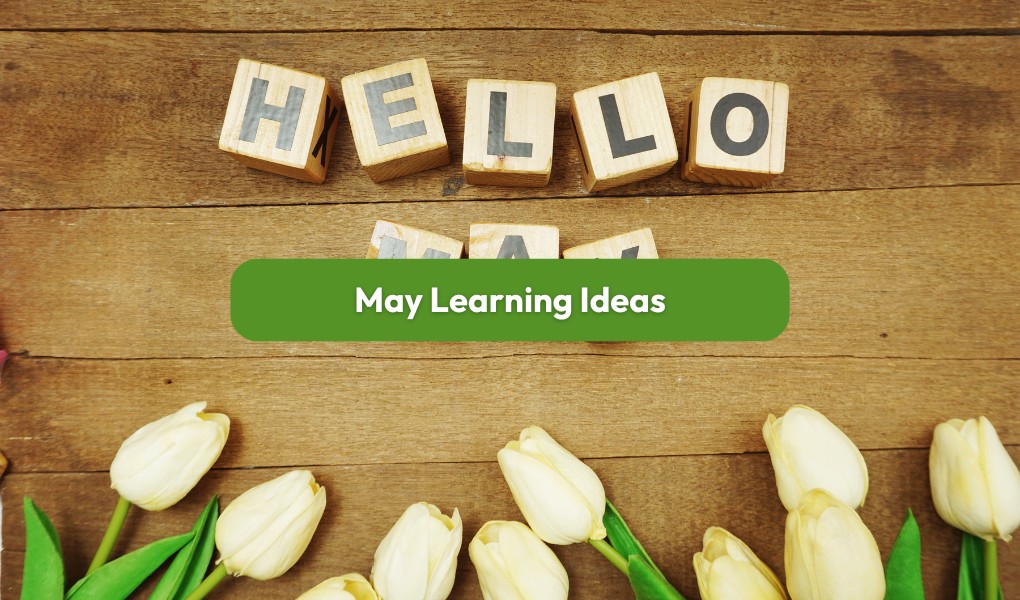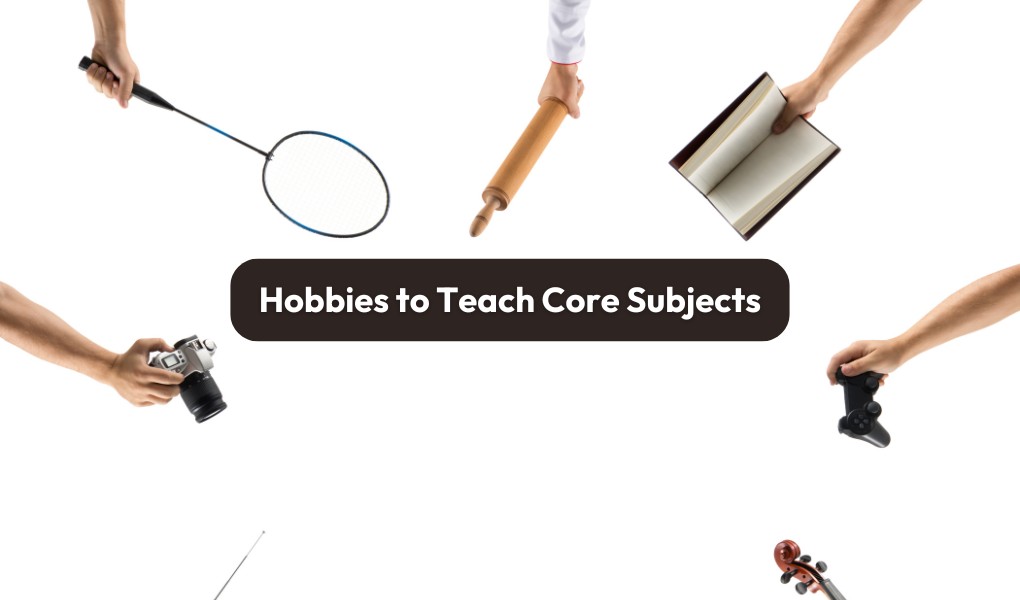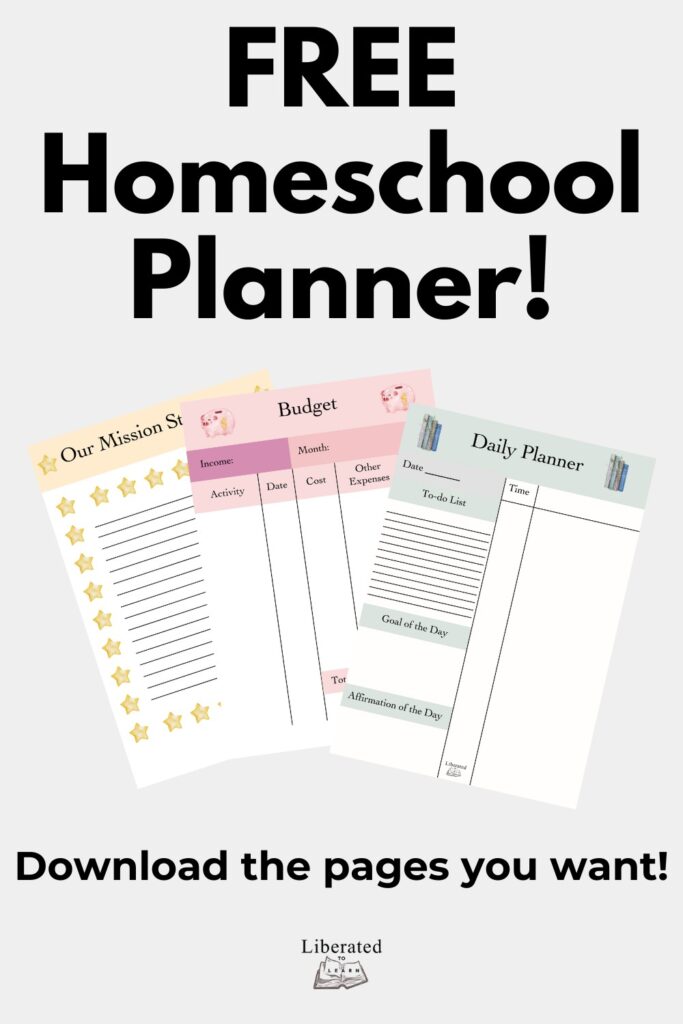If you’re unschooling then it’s likely that mostly everything you do is driven by your child’s curiosity. But it’s also likely that you’ll be looking for some unschooling learning ideas to help inspire them and ignite passions.

If you’re unschooling then it’s likely that mostly everything you do is driven by your child’s curiosity. But it’s also likely that you’ll be looking for some unschooling learning ideas to help inspire them and ignite passions.
January is a great time to explore new ideas and gain a bit of learning inspo, especially after the Christmas break. If you’re struggling on what to do, here are some fun unschooling learning ideas to get you started in January.

January Learning Ideas for Your Unschooled Child
Follow Their Interests
A big part of unschooling is following your child’s interests, and often we can inspire these interests too. Here are some learning ideas based on what your unschooled child might be interested in.
If your unschooled child loves:
Hands-on or building activities
You could:
- Learn about snow and make fake snow
- Make an ice fort construction
- Make an ice sculpture
- Create a winter scrapbook
- Build a simple weather station
- Grow crystals
- Make a bird feeder or bird bath
- Make a DIY lava lamp
- Build an indoor or outdoor fort or den
Nature
You could:
- Observe and track the weather
- Go on a winter walk and collect sticks, stones and other nature bits
- Learn about the birds and animals you see
- Learn about animals and birds which are adapted to cold climates
- Make a sled
- Go stargazing
- Learn about hibernation and migration
- Build a tiny habitat
- Visit a pond or stream and observe the wildlife around it
- Identify plants, flowers and trees
- Visit a local animal shelter to volunteer or simply spend time with animals
- Go cloud watching and learn about different types of clouds
- Set up a terrarium and learn about ecosystems
Arts & crafts
You could:
- Make nature prints by pressing leaves or pine cones into clay or paint
- Create homemade candles with winter scents
- Design and sew costumes for a winter play
- Learn about weaving by making a loom with cardboard and yarn
- Paint a mural of a favourite winter scene or story
Science & experimenting
You could:
- Make ice cream in a bag
- Test different materials for the best insulation and keeping warm
- Build a model of the solar system and learn about why we have seasons
- Make a sundial and learn about shadows
- Do a snow volcano experiment
- Make a DIY thermometer
Technology
You could:
- Make a mini stop-motion film with lego or clay
- Create a winter-themed game or animation
- Learn how to edit photos or videos in Canva or CapCut
- Build a winter robot
Music & performing
You could:
- Write a winter-inspired song or play
- Create a winter puppet show
- Make a hand-made instrument using natural materials
- Learn a traditional dance from another culture
- Create your own radio show
Reading & writing
You could:
- Create a cosy book nook with wintry decorations
- Record a winter-inspired audiobook or podcast talking about winter themes
- Read books that had a January release date
- Write a family story together and each add your own paragraph
Cooking
You could:
- Try making different hot chocolate recipes
- Make a winter meal from another culture
- Make a trail mix
- Bake bread and learn about yeast
- Make your own sweets and lollipops
Maths & problem-solving
You could:
- Look at patterns and symmetry of a snowflake
- Design a budget for a pretend winter trip away
- Do maths equations on a winter walk
- Learn about geometry by designing a winter theme park or wonderland
Learn Practical Life Skills
If there’s anything worth including when thinking of unschooling learning ideas, it’s life skills. They are invaluable in helping children to thrive as they grow, and the best thing about life skills is that there is something for every interest.
Cooking skills
- Follow a grocery list and plan and cook a family meal
- Knead and shape dough to make certain foods like pizza and pasta
- Learn how to use a knife safely and cut vegetables
- Learn about expiration dates of food and how to store it
- Food safety when cooking with raw meat
- Using various kitchen equipment
- Make food using unconventional methods
- Experimenting and combining flavours
Home & garden
- Learn how to sew a button or fix a tear
- Grow your own vegetable patch
- Start composting
- Grow herbs indoors
- Learn basic home repair and using certain tools
- Organise and declutter
- Decorate a room
- Learn about reusing and recycling
- Cleaning and laundry
Outdoor & survival
- How to build a fire safely
- Learn to tie knots and their uses in everyday life and outdoor activities
- Identify edible, medicinal and toxic plants
- How to read a map and navigate using a compass and GPS
- Foraging for safe food
- Finding water and learning about insulation to keep warm
Social skills
- Role play common social situations in everyday life
- Talking on the phone and making appointments
- Organise a group activity
- Learn how to calmly resolve conflict
- Write kind messages to friends, family, and strangers
Money & entrepreneurship
- Set up a pretend store and manage money
- Learn about online selling and passive income
- Learn how to start a small business
- Understand spending, saving, and budgeting
- Learn how to compare prices and make savings
Health & self-care
- How to make and use a first-aid kit
- Learn about emotional regulation techniques
- Learn the importance of staying hydrated and eating healthy
- Keep a sleep diary and try different sleep routines
- How to set personal boundaries
Transportation
- How to ride a bike
- Pumping up a flat bike tyre
- Using public transport and reading maps and schedules
- Understand road safety
Let Curiosity Lead
Curiosity ignites every learning experience. It’s how we discover certain interests and learn new things. That’s why one of the best unschooling learning ideas is to simply let your child’s curiosity lead the way.
When your child starts to ask questions about certain things, take the opportunity to learn more about them and do related activities.
Here are some unschooling-inspired learning ideas that embrace curiosity and encourage your child to follow their interests.
If your child asks: “How does that work?”
You could:
- Explore how snowflakes form and freeze water with salt in different shapes.
- Investigate how insulation works by testing different materials to keep a hot drink warm.
- Learn about temperature changes by making a DIY thermometer using water, rubbing alcohol, and food coloring.
- Learn about how animals hibernate and create a den.
- Study how ice forms and experiment with different ways to melt it.
If your child loves to ask “Why?”
You could:
- Investigate why roads are salted in winter and test how salt affects ice.
- Explore why the days are shorter in January and learn about the earth’s tilt.
- Research why some birds stay for the winter while others migrate south.
- Test why certain winter clothes keep us warm by comparing materials like wool, cotton, and synthetic fabrics.
- Watch a video or create an experiment to learn why our breath is visible in cold air.
If your child shows interest in stories or history
You could:
- Learn about how people in the past stayed warm during the winter, such as using hearths or fur-lined clothing.
- Read about how arctic explorers survived and what tools they used.
- Research the history of snowmen or sledding and create your own versions.
- Learn about the origins of New Year’s traditions and make a family tradition inspired by history.
- Explore folktales or myths about winter from different cultures, like Norse, Inuit, or Russian stories.
If your child notices something unusual
You could:
- Explore how icicles form by dripping water onto a cold surface.
- Investigate what causes frost to appear on windows and try creating frost designs with water and salt.
- Notice how the sun appears lower in the sky and research why this happens in winter.
If your child is inspired by big ideas or philosophical questions
You could:
- Talk about why people celebrate fresh starts during the New Year
- Ask them to imagine what it would be like to live in a world of endless winter or no winter at all.
- Explore why humans need seasons and how they impact agriculture and life.
- Discuss the balance between humans and nature in harsh climates.
If your child just wants to ‘do their own thing’
You could:
- Give them tools to make their own winter experiments, like measuring melting snow or tracking shadows.
- Provide them with books, supplies, or videos on any winter topic they’re curious about.
- Help them document their explorations with photos, journals, or creations.
- Support them in building or designing something inspired by winter.
- Let them follow their curiosity into unexpected winter projects, even if it’s just playing in the snow or cosying up with hot chocolate and a book.
Curiosity-Led Unschooling Questions
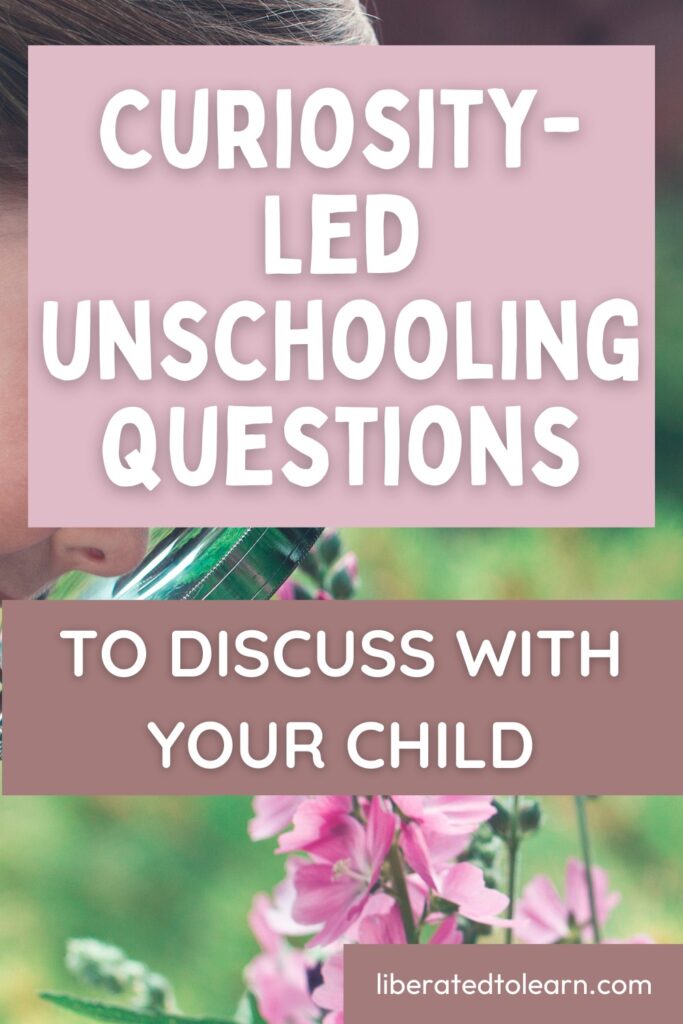
Nature Questions
- Why is snow white?
Explore the science of light reflection and refraction using snow or white objects. - Why do we see our breath in cold weather?
Exhale onto different surfaces (glass, mirror, air) and compare what happens in cold vs. warm conditions. - How do icicles form?
Observe icicles forming on roofs or outdoor surfaces. If you can’t find any, create your own. - Why do some animals hibernate?
Research hibernating animals and create a small model hibernation den
Creative Science Questions
- How does frost form?
- Why do some plants survive winter while others don’t?
- What is the coldest temperature you can create at home?
Winter and Space
- What are the Northern Lights?
Watch videos or read about the aurora borealis. - Why are the days so short in January?
- What would it be like to live in the Arctic?
Learn about indigenous Arctic people and traditions.
Weather-Related
- What happens when snow melts?
- Why do roads get icy?
- How much snow does a cloud hold?
Winter Animal Life
- How do animals stay warm in winter?
Learn about animal adaptations. - Where do birds go in winter?
- What do squirrels eat when there’s snow everywhere?
Winter Around the World
- What’s winter like in other parts of the world?
- Why do some countries celebrate Lunar New Year in January?
- What’s the coldest place on Earth?
Big Questions
- What would happen if it was always winter?
Write a story, draw a picture, or discuss what animals, plants, and people would need to survive. - Why do people celebrate the New Year?
- Why do we love winter?
Ask family members what they like most about winter and create a collage or journal entry about your own favourite winter moments.
Extra Unschooling Activities
- Start a winter curiosity journal
Let your child jot down any questions they have about winter. - Create a “Why” collage
- Host a curiosity Q&A night:
Let your child present something they’ve learned about winter and answer questions about it. - Create a winter care package
- Design a winter shelter
- Create a winter calendar
- Explore a winter-inspired interest
We hope you enjoy trying out these different unschooling learning ideas for January! As always, happy home educating!
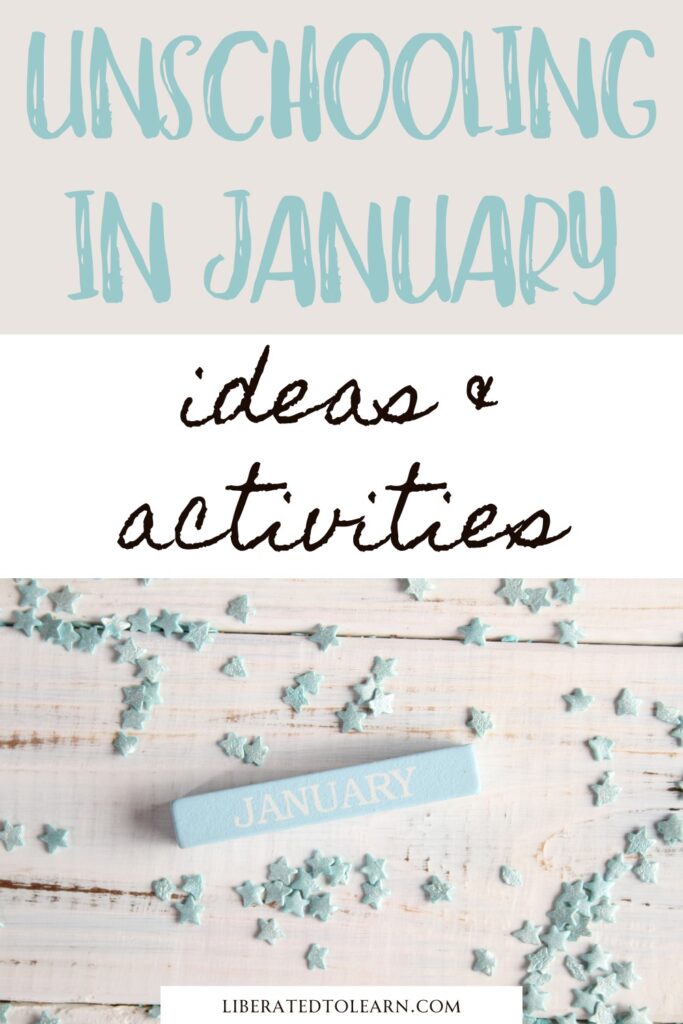
m@liberated
Want more from Liberated to Learn?
Subscribe to stay updated about new posts, resources and giveaways!




